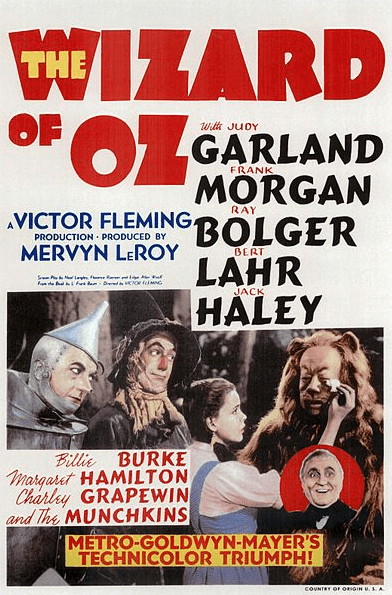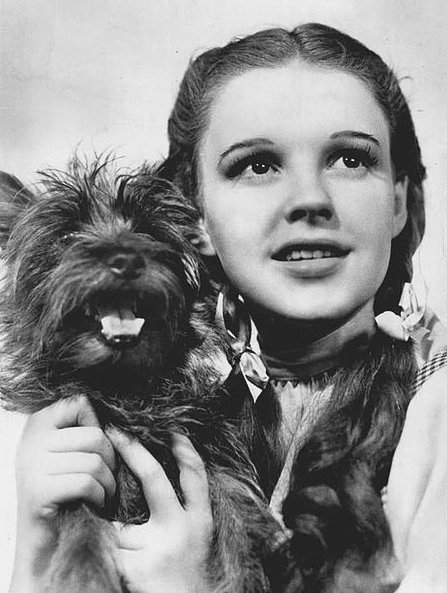History was made at the Strand Theatre in Oconomowoc, Wisconsin, on 12 August 1939 with the premiere of a remarkable movie that is now recognized as one of the greatest films ever made: The Wizard of Oz. This fantasy musical featured an excellent cast – led by 16-year-old Judy Garland in the lead role of Dorothy – engaging songs, dazzling color, and intriguing special effects.
[Update, according to Wikipedia: “The film’s first sneak preview was held in San Bernardino, California. The film was previewed in three test markets: on 11 August 1939 at Kenosha, Wisconsin, and Cape Cod, Massachusetts; and at the Strand Theatre in Oconomowoc, Wisconsin, on 12 August 1939. The Hollywood premiere was on 15 August 1939 at Grauman’s Chinese Theatre.]

Based on the wildly popular and successful 1900 children’s book by L. Frank Baum, the movie’s creation by Hollywood powerhouse Metro-Goldwyn-Mayer (MGM) was a tangled production with various actors, directors and screenwriters coming and going. In the end, the main cast featured Judy Garland with Ray Bolger, Jack Haley and Bert Lahr; Victor Fleming was the primary director; and Noel Langley the main screenwriter. MGM was emboldened to create a feature film from a children’s book after the enormous success of Walt Disney’s Snow White and the Seven Dwarfs, which premiered on 21 December 1937.

The Wizard of Oz cost nearly $3 million to produce and eventually, thanks to re-releases, grossed over $16 million. What made the movie an enduring part of American culture was its annual showing on television, starting in 1956. The Library of Congress designated The Wizard of Oz the most-watched film of all time.
The following two articles helped introduce The Wizard of Oz to newspaper readers in 1939. The first was written on August 12, the day the film premiered, providing some production details. The second article appeared six days later, presenting a glowing review of the movie.

Here is a transcription of this article:
Fantasy Seen as Film Hit
HOLLYWOOD, Calif., Aug. 12 (UP) – Best movie that Metro-Goldwyn-Mayer has manufactured in many a moon is The Wizard of Oz. It is comparable only to Disney’s Snow White – and many people are going to think it’s better.
Odds are that you’ll see it. The following facts may help you enjoy it:
Last winter when the Wizard was in production, minority stockholders kicked about the fact that Producer Mervyn Leroy was earning $6,000 a week. That’s $312,000 a year, or a tremendous salary for a hired hand in a picture studio. The stockholders claimed it was way too much.
They may decide Leroy’s wage was one of the best investments the company ever made, because the picture seems destined to make net profits into the millions, as did Snow White. Now that the Wizard is finished and about to be given its world premiere at $5.50 a seat, Leroy has taken a salary cut. He gets only $4,000 a week.
The picture, as you may have gathered from the advertisements, is merely the retelling in color on the screen of L. Frank Baum’s famous book for children, about Dorothy’s adventures with the tin woodsman, the scarecrow and the cowardly lion in the land of Oz. The book has sold 8,000,000 copies so far. Sam Goldwyn held onto the picture rights for years, but finally sold them to Leroy after the latter had wangled $3,500,000 of Metro money to make the film.
It took him five months to shoot the film, after a couple of surprising false starts, and four more months to dub in the sound. The result, as unwound today in a studio projection room, is an adventure into pure fantasy, as gay and as exciting perhaps as any movie Hollywood ever made.
One scene you’ll see is that of Dorothy plucking an apple from a tree. This makes the tree angry. It snatches the apple away from her and slaps her on the wrist. How do you think Metro wangled that?
Well sir, the experts built a flexible rubber tree, put a man inside of it and zipped up the bark up the back. He did the apple snatching.

Here is a transcription of this article:
The Wizard of Oz
As refreshing as childhood, as colorful as the rainbow and entertaining as one’s favorite author, “The Wizard of Oz” hits a high entertainment level for both children and adults.
Seen in a preview, the film is nearly breathtaking in the brilliance of its coloring of the Land of Oz and almost startling in the ingenuity utilized for the various effects. With all characters portrayed by people, it is little short of amazing to see an apple tree retake an apple from Dorothy and slap her on the wrist for taking it.
It is a film of such magnitude, despite its source in a child’s book, and there are so many outstanding features that one hesitates to attempt a description. Dorothy, as played by the rapidly growing-up Judy Garland, is little short of perfection in the role. One is alternately thrilled, sad, excited and happy with her at the various stages of the film.
But others will name Bert Lahr’s comedy as the film’s high spot. As the lion without courage, his eagerness to seek that courage from the Wizard of Oz, along with his antics as the cowardly beast, will tickle the grownups as well as thrill the youngsters.
Ray Bolger as the scarecrow seeking a brain; Jack Haley as the tin man seeking a heart; Frank Morgan as the professor and as the wizard; Miss Burke as the good witch and Margaret Hamilton as the broomstick-riding witch who writes a message in the sky from her magic stick, all are so completely satisfying that one must toss a bouquet to the casting director.
So familiar is the story of the little Kansas girl who is caught in a storm and in her mind, or actually, according to Dorothy, visits Munchkinland and the Land of Oz with all the adventures known to almost every child of the nation, that a retelling would be trite indeed.
The film opens on the familiar Kansas farm land as Dorothy and her dog, Toto, scamper home.
This first part of the film and afterward when Dorothy returns to the land of her Aunt Em, are colored in a sepia tone that is a fascinating departure from usual black and white. The remainder of the picture not only is color, but is brilliant. It also is sensibly and appropriately done.
The scene in Munchkinland where Dorothy gets her purple shoes as a protection against the evil witch is beautiful with a veritable dwarf city produced with scores and scores of midgets used effectively.
The long yellow road that leads to Oz, the poppy field by which the evil witch tries to overcome Dorothy, and finally Oz, the towered colorful city with the “horse of another color” that changes hues as he draws the carriage for them, all are beautiful.
The picture is a glorious effort and doubtless will rank among the best pictures of the year, in this reviewer’s opinion. It should be on the show list for the week without question.
–F. C.
Note: An online collection of newspapers, such as GenealogyBank’s Historical Newspaper Archives, is not only a great way to learn about the lives of your ancestors – the old newspaper articles also help you understand American history and the times your ancestors lived in, and the news they talked about and read in their local papers. Do you remember the first time you saw The Wizard of Oz? Please share your stories with us in the comments section.

The Wizard of Oz had what was previously thought to be its world premiere engagement at The Strand Theater in Oconomowoc, Wisconsin, but recent research has proven this to not be true!
The reality is that the Hollywood premiere was originally scheduled for August 10th but was moved to the 15th. The film was already scheduled for several dates around the country. According to newspaper records, the film was scheduled to premiere in several cities and towns in the Midwest on August 11, although its first showing was on August 10th in Green Bay, Wisconsin, followed by: August 11 (Cape Cod, Massachusetts, Kenosha, Neenah, and Appleton, Wisconsin); August 12 (Oconomowoc, Wisconsin); August 13 (Portsmouth, New Hampshire, and Racine, Rhinelander, and Sheboygan, Wisconsin).
Oconomowoc has laid claim to being the location of the film’s world premiere, and it was reported as such for several decades, but in fact the film actually (and quietly) premiered on August 10th in Green Bay, Wisconsin.
Thanks for this more recent information, Scott! I have updated the article accordingly. We appreciate you taking the time to write us.